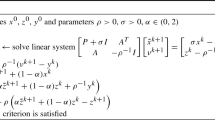Abstract
This paper investigates the effects of adding input redundancies repeatedly into linear quadratic regulator (LQR) problems. As the number of input redundancies increases, three equivalent conditions are stated to guarantee a strict decrease of the minimum cost, which is constrained by a pair of lower and upper bounds. The contribution of a new added input redundancy to reduce the minimum cost will diminish after more redundancies are added. Moreover, the minimum cost will converge to zero as the number of input redundancies goes toward infinity, which is proven by transferring the LQR problem into a cheap control problem.
Similar content being viewed by others
References
Ikeda, Y., Hood, M.: An application of L1 optimization to control allocation. In: Proc. AIAA Guidance, Navigation and Control Conference and Exhibit, Denver, CO, August 2000
Shertzer, R.H., Zimpfer, D.J., Brown, P.D.: Control allocation for the next generation of entry vehicles. In: Proc. AIAA Guidance, Navigation, and Control Conference and Exhibit, Monterey, CA, August 2002
Servidia, P.A., Pena, R.S.: Spacecraft thruster control allocation problems. IEEE. Trans. Autom. Control. 50 (2005)
Sørdalen, O.J.: Optimal thrust allocation for marine vessels. Control Eng. Pract. 5, 1223–1231 (1997)
Fossen, T.I., Johansen, T.A.: A survey of control allocation methods for ships and underwater vehicles. In: 14th Mediterranean Conference on Control and Automation, Ancona, Italy (2006)
Spjøtvold, J., Johansen, T.A.: Fault tolerant control allocation for a thruster-controlled floating platform using parametric programming. In: Proc. IEEE Conference on Decision and Control and 28th Chinese Control Conference, Shanghai, China (2009)
Plumlee, J.H., Bevly, D.M., Hodel, A.S.: Control of a ground vehicle using quadratic programming based control allocation techniques. In: Proc. 2004 American Control Conference, Boston, MA (2004)
Schofield, B., Hagglund, T., Rantzer, A.: Vehicle dynamics control and controller allocation for rollover prevention. In: Proc. 2006 IEEE International Conference on Control Applications, Munich, Germany (2006)
Harkegard, O., Glad, S.T.: Resolving actuator redundancy-optimal control vs. control allocation. Automatica 41 (2005)
Chen, C.T.: Linear System Theory and Design, 3rd edn. Oxford University Press, New York (1999)
Wonham, W.M.: Linear Multivariable Control: A Geometric Approach. Springer, New York (1979)
Duan, Z., Huang, L., Yang, Y.: The effects of redundant control inputs in optimal control. Science in China Series F (2009)
Kwakernaak, H., Sivan, R.: The maximally achievable accuracy of linear optimal regulators and linear optimal filters. IEEE. Trans. Autom. Control AC17 (1972)
Francis, B.: The optimal linear-quadratic time-invariant regulator with cheap control. IEEE. Trans. Autom. Control 24 (1979)
Schmid, R., Ntogramatzidis, L.: On the design of non-overshooting linear tracking controllers for right-invertible systems. In: Proc. IEEE Conference on Decision and Control and 28th Chinese Control Conference, Shanghai, China (2009)
Sontag, E.D.: Mathematical Control Theory: Deterministic Finite-Dimensional Systems, 2nd edn. Springer, New York (1998)
Wang, C.Z., Qin, H.S.: Optimal Control Theory. Science Press, Beijing (2003) (in Chinese)
Huang, L.: Fundamental Theory on Stability and Robustness, pp. 142–227. Science Press, Beijing (2003) (in Chinese)
Zhou, K., Doyle, J.C., Glover, K.: Robust and Optimal Control, pp. 368–449. Prentice Hall, New York (1996)
Saberi, A., Sannuti, P.: Cheap and singular controls for linear quadratic regulators. IEEE. Trans. Autom. Control AC-32 (1987)
Author information
Authors and Affiliations
Corresponding author
Additional information
Communicated by Felix L. Chernousko.
This work was supported by the National Natural Science Foundation of China under Grants 60874011, 90916003.
Rights and permissions
About this article
Cite this article
Peng, Z., Yang, Y. & Huang, L. The Effects of Adding Input Redundancies in Linear Quadratic Regulator Problems. J Optim Theory Appl 150, 341–359 (2011). https://doi.org/10.1007/s10957-011-9845-z
Published:
Issue Date:
DOI: https://doi.org/10.1007/s10957-011-9845-z




